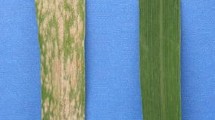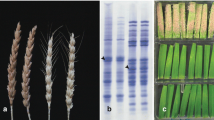Abstract.
The powdery mildew resistance has been transferred from an Israeli wild emmer (Triticum dicoccoides) accession 'G-305-M' into common wheat by crossing and backcrossing (G-305-M/781//Jing 411*3). Genetic analysis showed that the resistance was controlled by a single dominant gene at the seedling stage. Among the 102 pairs of SSR primers tested, four polymorphic microsatellite markers (Xpsp3029, Xpsp3071, Xpsp3152 and Xgwm570) from the long arm of chromosome 6A were mapped in a BC2F3 population segregating for powdery mildew resistance and consisting of 167 plants. The genetic distances between the resistance gene and these four markers were: 0.6 cM to Xpsp3029, 3.1 cM to Xpsp3071, 11.2 cM to Xpsp3152 and 20.4 cM to Xgwm570, respectively. The order of these microsatellite loci agreed well with the established microsatellite map of chromosome arm 6AL. We concluded that the resistance gene was located on the long arm of chromosome 6AL. Based on the origin and chromosomal location of the gene, it is suggested that the resistance gene derived from 'G-305-M' is a novel powdery mildew resistance gene and is temporarily designated MlG.
Similar content being viewed by others
Author information
Authors and Affiliations
Additional information
Electronic Publication
Rights and permissions
About this article
Cite this article
Xie, C., Sun, Q., Ni, Z. et al. Chromosomal location of a Triticum dicoccoides-derived powdery mildew resistance gene in common wheat by using microsatellite markers. Theor Appl Genet 106, 341–345 (2003). https://doi.org/10.1007/s00122-002-1022-1
Received:
Accepted:
Issue Date:
DOI: https://doi.org/10.1007/s00122-002-1022-1




